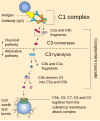File:Complement pathway.svg
Appearance

Size of this PNG preview of this SVG file: 498 × 600 pixels. Other resolutions: 199 × 240 pixels | 398 × 480 pixels | 637 × 768 pixels | 850 × 1,024 pixels | 1,700 × 2,048 pixels | 1,680 × 2,024 pixels.
Original file (SVG file, nominally 1,680 × 2,024 pixels, file size: 26 KB)
File history
Click on a date/time to view the file as it appeared at that time.
| Date/Time | Thumbnail | Dimensions | User | Comment | |
|---|---|---|---|---|---|
| current | 00:53, 29 September 2020 |  | 1,680 × 2,024 (26 KB) | Asierog | Spanish translation added, C2a changed for C2b in all languages |
| 12:16, 6 February 2020 |  | 1,680 × 2,024 (24 KB) | Whidou | Add French translation | |
| 14:29, 16 June 2019 |  | 1,680 × 2,024 (23 KB) | SMP | Catalan spelling | |
| 01:33, 6 September 2016 |  | 1,680 × 2,024 (23 KB) | DadOfBeanAndBug | Reverted to version as of 01:30, 6 September 2016 (UTC) | |
| 01:31, 6 September 2016 |  | 1,680 × 2,024 (23 KB) | DadOfBeanAndBug | Reverted to version as of 20:44, 1 December 2015 (UTC) | |
| 01:30, 6 September 2016 |  | 1,680 × 2,024 (23 KB) | DadOfBeanAndBug | en: changed membran -> membrane | |
| 20:44, 1 December 2015 |  | 1,680 × 2,024 (23 KB) | Perhelion | lang +ca +gl (+fix de) | |
| 12:38, 1 December 2015 |  | 1,680 × 2,020 (20 KB) | Perhelion | minor tweak | |
| 01:40, 1 December 2015 |  | 1,680 × 2,020 (27 KB) | Perhelion | =={{int:filedesc}}== {{Information |Description= {{en|The complement system is made up of about 25 proteins that work together to “complement” the action of antibodies in destroying bacteria. Complement proteins circulate in the blood in an inactiv... |
File usage
The following 12 pages use this file:
Global file usage
The following other wikis use this file:
- Usage on ar.wikipedia.org
- Usage on bs.wikipedia.org
- Usage on ca.wikipedia.org
- Usage on cs.wikipedia.org
- Usage on de.wikipedia.org
- Usage on de.wikibooks.org
- Usage on es.wikipedia.org
- Usage on fa.wikipedia.org
- Usage on fr.wikipedia.org
- Usage on gl.wikipedia.org
- Usage on he.wikipedia.org
- Usage on hy.wikipedia.org
- Usage on ja.wikipedia.org
- Usage on ko.wikipedia.org
- Usage on mk.wikipedia.org
- Usage on nl.wikipedia.org
- Usage on pl.wikipedia.org
- Usage on pt.wikipedia.org
- Usage on ru.wikipedia.org
- Usage on sh.wikipedia.org
- Usage on sr.wikipedia.org
- Usage on tr.wikipedia.org
- Usage on vi.wikipedia.org
- Usage on www.wikidata.org
- Usage on zh.wikipedia.org










